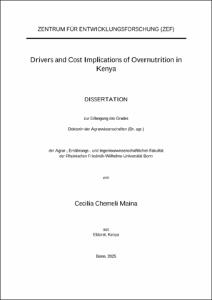Drivers and Cost Implications of Overnutrition in Kenya
Drivers and Cost Implications of Overnutrition in Kenya
| dc.contributor.advisor | von Braun, Joachim | |
| dc.contributor.author | Maina, Cecilia Chemeli | |
| dc.date.accessioned | 2025-06-10T09:45:22Z | |
| dc.date.issued | 10.06.2025 | |
| dc.identifier.uri | https://hdl.handle.net/20.500.11811/13124 | |
| dc.description.abstract | Kenya's population is experiencing a rising prevalence of overweight and obesity. This trend poses a significant concern, as overweight and obesity are major risk factors for non-communicable diseases (NCDs), leading to increased human suffering, raised mortality, and substantial private and social costs. This issue coexists with ongoing challenges of undernutrition and infectious diseases, further straining the country's underfunded health system. The increase in overweight and obesity is driven by economic change, urbanization, and technological advancements, which have led to shifts in lifestyles and eating habits, including higher consumption of processed foods and reduced physical activity.
This study first examines how socio-economic differences in food choice motives affect diet diversity and weight outcomes. The findings show notable differences in food choice motives by socio-economic group. High income is associated with higher prioritization of health, mood, sensory appeal, and weight, while higher education is linked to increased health and sensory motivations and reduced familiarity concerns. Results from mediation analysis show that sensory motives account for 29% of the income-BMI relationship and 30% of the education-BMI link. Familiarity concerns negatively mediate the education-BMI association by -4%. Health and sensory motives also positively mediate the education-diet diversity association by contributing 11% and 4%, respectively. Secondly, the study evaluates the impact of various types of physical activity (PA)—work, leisure, and transport—along with sedentary time on BMI and NCD outcomes, using 2015 and 2022 data with panel fixed effects, probit, and entropy balancing methods. Findings indicate a decline in overall physical activity (measured in metabolic equivalents, or METs), alongside increases in sedentary time, BMI, and the incidence of NCDs. Work-related PA was the largest contributor to total PA, followed by transport and leisure. An additional MET-hour per week of vigorous work, leisure, and transport PA was linked to reductions in BMI by 0.03%, 0.16%, and 0.05%, respectively. Similarly, increases in vigorous work, moderate work, and leisure PA decreased the probability of having an NCD by 0.15%, 0.11%, and 0.53%, respectively. In comparison, sedentary time was associated with a 0.18% increase in NCD risk. Finally, the study investigates the health costs of Kenya's current food system, focusing on the impact of unhealthy diets using 2022 Kenya Demographic and Health Survey data and two-part and instrumental variable methods. Results show that overweight and obesity increase the likelihood of outpatient and inpatient medical expenditures by 3.3 and 1.4 times, respectively. Overweight and obesity raised outpatient monthly expenditures by KES 445.0 (.61) and annual inpatient costs by KES 16,942.8 (7.33). An increase of one BMI unit raises marginal outpatient monthly healthcare spending by KES 277.8 (.25) and annual inpatient spending by KES 5,119.0 (.49). The social costs of overweight and obesity among adult women in 2022 amounted to .11 billion, or KES 10,557.2 (.57) per woman. This dissertation concludes by highlighting potential cost-effective policies to reduce the prevalence of overweight and obesity, including implementing a 20% sugar-sweetened beverage tax, mandatory kilojoule menu labeling, front-of-pack nutrition labeling, revising public food procurement policies, mass media campaigns for healthier diets, restricting harmful food marketing to children, promoting breastfeeding practices, and community-wide public education campaigns on physical activity. | en |
| dc.language.iso | eng | |
| dc.rights | In Copyright | |
| dc.rights.uri | http://rightsstatements.org/vocab/InC/1.0/ | |
| dc.subject.ddc | 330 Wirtschaft | |
| dc.subject.ddc | 630 Landwirtschaft, Veterinärmedizin | |
| dc.title | Drivers and Cost Implications of Overnutrition in Kenya | |
| dc.type | Dissertation oder Habilitation | |
| dc.identifier.doi | https://doi.org/10.48565/bonndoc-568 | |
| dc.publisher.name | Universitäts- und Landesbibliothek Bonn | |
| dc.publisher.location | Bonn | |
| dc.rights.accessRights | embargoedAccess | |
| dc.date.embargoEndDate | 15.06.2026 | |
| dc.identifier.urn | https://nbn-resolving.org/urn:nbn:de:hbz:5-82767 | |
| dc.relation.doi | https://doi.org/10.1371/journal.pone.0302510 | |
| ulbbn.pubtype | Erstveröffentlichung | |
| ulbbnediss.affiliation.name | Rheinische Friedrich-Wilhelms-Universität Bonn | |
| ulbbnediss.affiliation.location | Bonn | |
| ulbbnediss.thesis.level | Dissertation | |
| ulbbnediss.dissID | 8276 | |
| ulbbnediss.date.accepted | 06.05.2025 | |
| ulbbnediss.institute | Zentrale wissenschaftliche Einrichtungen : Zentrum für Entwicklungsforschung (ZEF) | |
| ulbbnediss.fakultaet | Agrar-, Ernährungs- und Ingenieurwissenschaftliche Fakultät | |
| dc.contributor.coReferee | Danquah, Ina | |
| ulbbnediss.contributor.orcid | https://orcid.org/0000-0003-4877-135X |
Dateien zu dieser Ressource

Dieses Dokument ist zur Zeit gesperrt.
Das Dokument erscheint in:
-
E-Dissertationen (1118)



